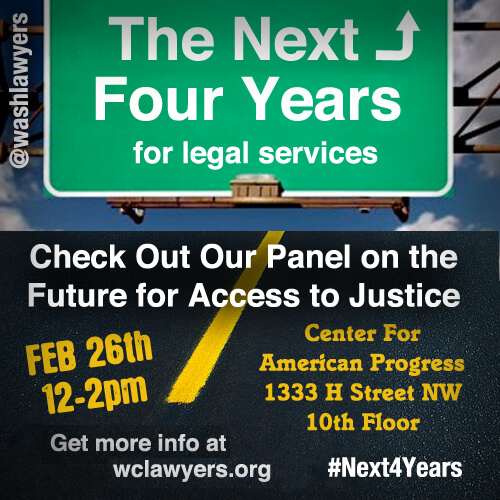
The Vanishing Legal Aid Lawyer
By Aleta Sprague
Our event next week at the Center for American Progress will explore a crucial issue facing the legal community: with legal services in crisis, how can lawyers, advocates, and policymakers ensure access to justice for low-income families?
A key driver of the crisis, of course, is inadequate funding. This will come as no surprise to any legal services attorneys reading this post, but the magnitude of the problem is staggering. Over the past three decades, Congress has cut the Legal Service Corporation’s budget by about seventy percent. Because LSC provides funding to about 134 legal aid programs–that employ approximately 58% of the attorneys working to provide legal aid–these organizations are scaling back.
Indeed, a recent survey revealed that LSC-funded organizations anticipated laying off 13.3% of their attorneys between 2010 and 2012, along with 15.4% of their paralegals and 12.7% of their support staff. For every attorney who is let go, between two and three hundred fewer clients will be served. And with the proportion of eligible legal aid clients accessing services already below 20%, any further cuts would be devastating.
At the same time, due to the recession, the need for legal services has never been greater—particularly for those facing debt and foreclosure. In 2008, LSC organizations handled 31,653 bankruptcy and debt relief cases; this number rose to 39,346 cases in 2010. Foreclosures reflect a similar trend; in New York, foreclosure cases rose by 683% between 2007 and 2011, and the cases “sit in the system” for an average of two and a half years.
Legal aid lawyers assist clients in foreclosure through loan modifications, mediation, and providing representation in foreclosure proceedings. These attorneys also were among the first to identify the “robo-signing” scandal in 2010. Still, a recent report from the Brennan Center for Justice revealed that the vast majority of families facing foreclosure in most states are not represented by counsel. In New Jersey, for example, 92.9% of the defendants in foreclosure cases in 2010 had no attorneys on record.
The practical impacts of these trends can be devastating. As the report documented, unrepresented parties in foreclosure proceedings often fail to present key pieces of evidence that could make a difference between staying in their homes or being out on the street. According to testimony from Martin Mack, the Executive Deputy Attorney General of New York, “[T]he lack of individual representation in foreclosure actions is one reason we have seen systemic abuses of the legal system by lenders and debt collectors.”
These types of hurdles extend beyond foreclosure cases. Litigants trying to access or reinstate their public benefits, secure a protection order, or file a discrimination claim will also encounter a range of unfamiliar processes, rules, and language that put them at a distinct disadvantage in court.
So that’s the bad news. Now what do we do about it? What’s the role of the pro bono community? Barring universal representation, how can we best serve the needs of unrepresented litigants? We’ll start answering these questions in our post on Monday, and be sure to attend the event on Tuesday as we explore some ideas, strategies, and solutions.






